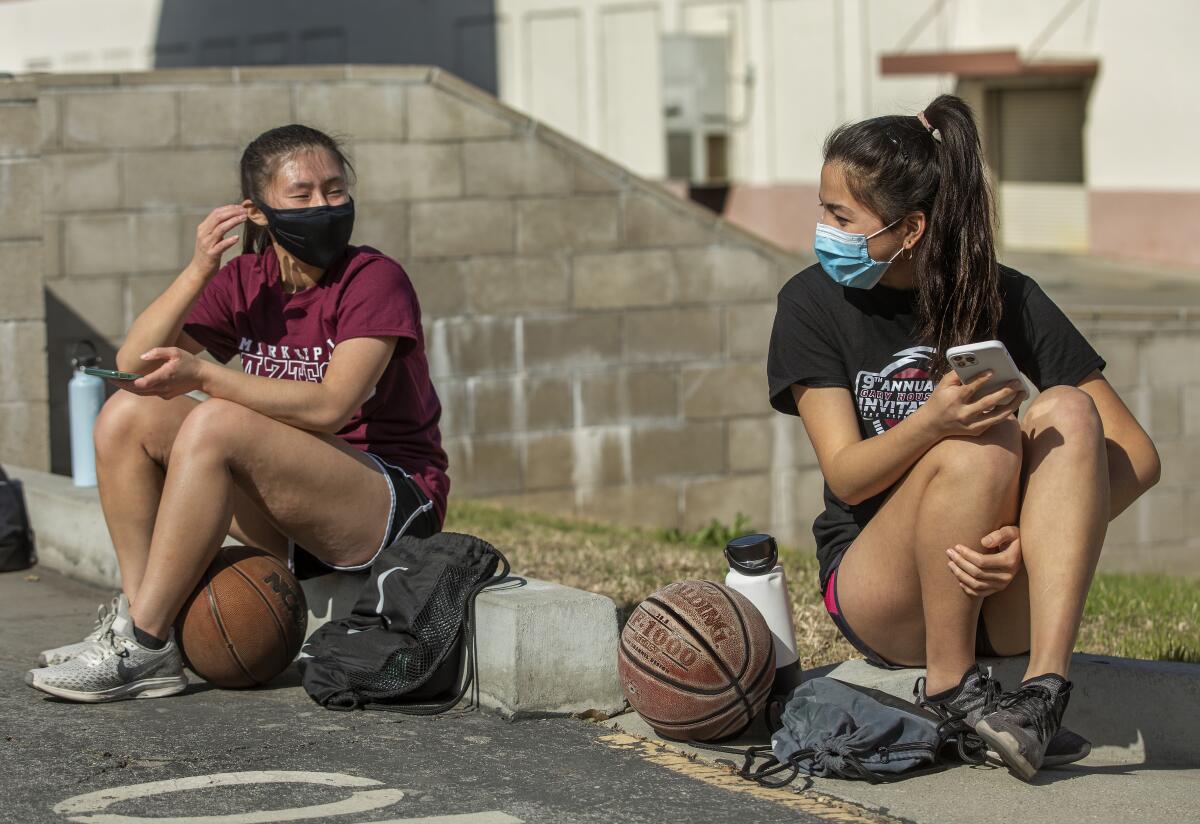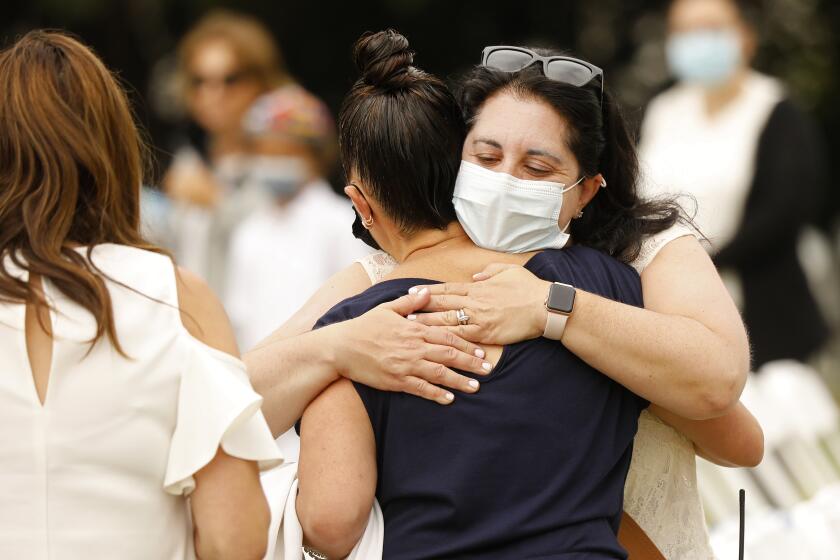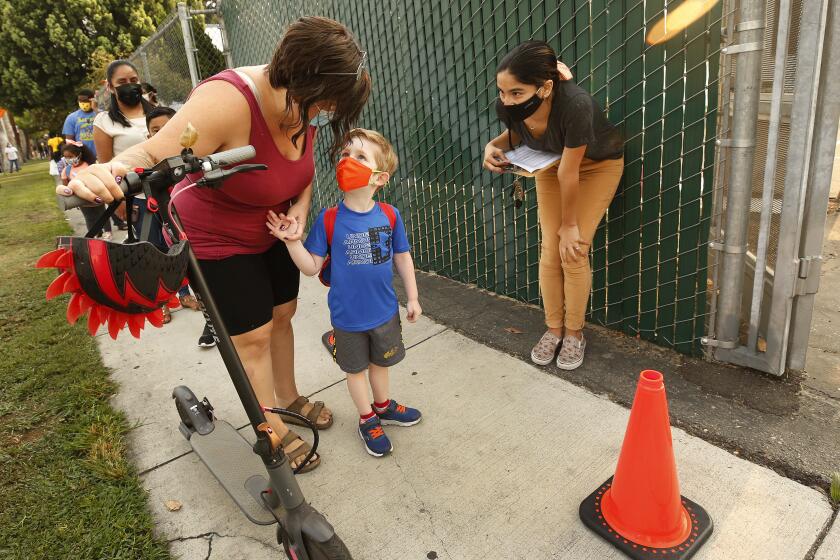How California turned the tide and achieved the lowest coronavirus transmission rate in the U.S.

- Share via
A few months ago, it looked as if California’s long-awaited reopening following massive coronavirus closures might be derailed by the highly contagious Delta variant.
Cases shot up in many areas, and then hospitals began to fill again.
There was a summer surge, but the curve has begun to flatten in many parts of California, which now has the lowest coronavirus case rate of any state in the nation.
The state has been among the national leaders in lowest case rates for the last week, as the number of new coronavirus infections continues to drop.
How did this happen?
While California has not reinstituted the sort of sweeping restrictions seen earlier in the pandemic, the state — along with many local health departments and other systems — has taken steps to tackle the Delta variant.
Notably, Los Angeles County reimposed a mandate in mid-July requiring all residents, regardless of vaccination status, to wear face coverings in public indoor places. A number of other counties have since followed suit.
Those who have yet to be vaccinated against COVID-19 must wear masks in indoor public settings throughout California, though state officials continue to only recommend — not require — that fully vaccinated people do likewise.
Some parts of the state also require that residents show they’ve either been vaccinated or recently tested negative before patronizing certain businesses or venues.
Statewide, such vaccine-or-testing proof is required for all attendees of indoor events with at least 1,000 people, according to the California Department of Public Health.
Other areas have gone further. In L.A. County, participants and workers at outdoor events with more than 10,000 attendees will need to provide proof of vaccination or show they’ve recently tested negative for the coronavirus, starting Oct. 7.
That requirement also applies to stadiums and large theme parks.
Proof of COVID-19 vaccination will also be required at indoor bars, wineries, breweries, nightclubs and lounges in L.A. County starting next month.
L.A. isn’t alone. San Francisco and Berkeley require customers 12 and older in indoor restaurants, bars and gyms to show proof of a COVID-19 vaccination. Contra Costa County has ordered those customers to show either proof of vaccination or a recent negative coronavirus test result. Palm Springs and neighboring Cathedral City have ordered patrons 12 and older to provide proof of COVID-19 vaccination or a recent negative coronavirus test to enter indoor restaurants and bars.
Given the protective power afforded by the vaccines, health officials have expanded the pool of people required to get shots.
California has ordered that healthcare workers statewide must be fully vaccinated against COVID-19. School employees also must be vaccinated or submit to at least a weekly coronavirus test.
Some cities and counties are also requiring their municipal employees to get vaccinated or tested regularly, and some individual businesses are doing likewise.
It’s not just workers, either. All children 12 and older in Los Angeles public schools also will have to be fully vaccinated by January.
Officials believe these types of measures helped slow the spread of the virus and also encouraged more people to get vaccinated.
The pace of COVID-19 vaccinations in Los Angeles County is so slow that there’s a risk of a “cycle of repeated surges every few months,” Los Angeles County’s public health director warns.
What about vaccinations?
California has higher vaccination rates than some states hard hit by the summer surge.
Officials say unvaccinated Californians continue to be infected at higher rates than their vaccinated counterparts.
During the week of Aug. 29 through Sept. 4, the average case rate among unvaccinated individuals was roughly eight times higher than for those who had been inoculated, according to the California Department of Public Health.
Almost 66% of Californians have received at least one dose of COVID-19 vaccine. But the rates vary widely by community.
In 11 of the state’s 58 counties, more than 70% of residents have received at least one shot to date, according to data compiled by The Times. However, 14 other counties have yet to partially inoculate even half of their population.
Unvaccinated people are also at far greater risk of being hospitalized. Of the hundreds admitted to L.A. County’s public hospital system since June 15 for a diagnosis primarily linked to COVID-19, 93% have been unvaccinated.
In the five states with the lowest levels of vaccination, the COVID-19 death rate this summer was more than triple the rate in the five states where vaccination is most common.
Where does California stand now?
As of Monday, California’s seven-day case rate was 95.3 per 100,000 people. The next-closest state was Connecticut, at 126.5.
The comparable rates over the same period were 385.1 cases per 100,000 people in Texas; 287.2 in Florida; 250.1 in Arizona; 234.7 in Oregon; and 202.5 in Nevada, federal data show.
The Centers for Disease Control and Prevention categorizes states’ coronavirus transmission levels in four tiers: the worst — high — is color-coded as red, followed by substantial (orange), moderate (yellow) and low (blue).
With the latest update, California’s coronavirus transmission level has once again fallen to “substantial.” Every other state currently remains in the “high” transmission category.
The federal figures illustrate the recent success California has had in turning the tide of the Delta-variant-fueled coronavirus wave.
How big has the fall been?
Over the last week, the state has reported an average of 8,849 new cases per day — down about 33% from two weeks ago, according to data compiled by The Times.
COVID-19 hospitalizations, too, have plummeted lately. At the height of the current surge, more than 8,300 coronavirus-positive patients were hospitalized at one time statewide. Now, that daily census has fallen to just about 6,000, state data show.
Many health experts believe mask mandates and tougher vaccine requirements will be needed in the coming months to avoid more serious coronavirus surges.
Where do we go from here?
Experts say a winter surge is likely, though how bad is hard to know.
The improvements are not guaranteed to last, they say.
In late July, Britain celebrated what seemed to be a recovery from its own Delta surge, an improvement that came about six weeks before California cases began dropping. But cases rose again in the U.K.
“The cautionary tale here is from the United Kingdom, where they had a very similar pattern, with a surge that dropped down across the summer ... which we’re seeing now. But then it went right back up again,” Dr. George Rutherford, a UC San Francisco epidemiologist and infectious disease expert, said at a recent campus forum.
The pace of COVID-19 vaccinations in Los Angeles County is slowing, and that is another concern.
There was an increase in vaccinations in late July and early August as the effects of the Delta surge became apparent, but that boost in weekly vaccinations has started to fade, according to data from the county Department of Public Health.
“In order to avoid a cycle of repeated surges every few months, we’ll need to see a significant increase in vaccination coverage,” Public Health Director Barbara Ferrer said.
In Los Angeles County, 75.9% of residents 12 and older have received at least one dose of vaccine, while 67.1% of residents of all ages have received at least one shot and 59.7% are fully vaccinated.
Rutherford has estimated that a community would need to have about 84% of the population vaccinated against COVID-19 to reach “herd immunity,” which occurs when enough people have immunity to interrupt sustained transmission of the disease.
“It’s going to take some substantial amounts of pediatric vaccination to get there,” Rutherford said at a recent campus forum.
More to Read
Sign up for Essential California
The most important California stories and recommendations in your inbox every morning.
You may occasionally receive promotional content from the Los Angeles Times.















